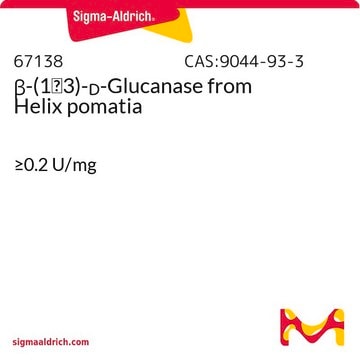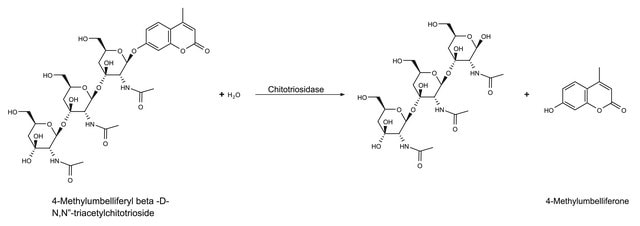C6137
Chitinase from Streptomyces griseus
lyophilized powder (essentially salt free), ≥200 units/g solid
Synonym(s):
N-acetyl-glucosaminidasechitobiase, Chitin digestion enzymes, poly(β-(1→4)-[2-acetamido-2-deoxy-D-glucoside])- glycanohydrolase
About This Item
Recommended Products
form
lyophilized powder (essentially salt free)
Quality Level
specific activity
≥200 units/g solid
mol wt
30 kDa
solubility
H2O: soluble 0.90-1.10 mg/mL
storage temp.
−20°C
Looking for similar products? Visit Product Comparison Guide
Related Categories
General description
The enzymatic hydrolysis of chitin to N-acetyl-D-glucosamine involves two consecutive enzyme reactions:
- The first reaction, chitodextrinase-chitinase, is a poly(β-(1→4)-[2-acetamido-2-deoxy-D-glucoside])- glycanohydrolase, which removes chitobiose units from chitin.
- The second activity is N-acetyl-glucosaminidasechitobiase, which cleaves the disaccharide to its monomer subunits, N-acetyl-D-glucosamine.
Application
Human health care: Asthma.
Pharma: preparation of chitooligosaccharides and N-acetyl D glucosamine,
Preparation of single-cell protein
Isolation of protoplasts from fungi and yeast
Control of pathogenic fungi
Treatment of chitinous waste, mosquito control and morphogenesis
Biochem/physiol Actions
Features and Benefits
Unit Definition
One new 1 hour unit = approx. 50 old 48 hour units.
substrate
Signal Word
Danger
Hazard Statements
Precautionary Statements
Hazard Classifications
Resp. Sens. 1
Storage Class Code
11 - Combustible Solids
WGK
WGK 3
Flash Point(F)
Not applicable
Flash Point(C)
Not applicable
Personal Protective Equipment
Certificates of Analysis (COA)
Search for Certificates of Analysis (COA) by entering the products Lot/Batch Number. Lot and Batch Numbers can be found on a product’s label following the words ‘Lot’ or ‘Batch’.
Already Own This Product?
Find documentation for the products that you have recently purchased in the Document Library.
Customers Also Viewed
Related Content
Find cell lysis and protein extraction reagents like cell lysis buffers, protein extraction kits, extraction enzymes, and other lysis enhancers for isolating and purifying proteins.
Find cell lysis and protein extraction reagents like cell lysis buffers, protein extraction kits, extraction enzymes, and other lysis enhancers for isolating and purifying proteins.
Find cell lysis and protein extraction reagents like cell lysis buffers, protein extraction kits, extraction enzymes, and other lysis enhancers for isolating and purifying proteins.
Find cell lysis and protein extraction reagents like cell lysis buffers, protein extraction kits, extraction enzymes, and other lysis enhancers for isolating and purifying proteins.
Our team of scientists has experience in all areas of research including Life Science, Material Science, Chemical Synthesis, Chromatography, Analytical and many others.
Contact Technical Service










